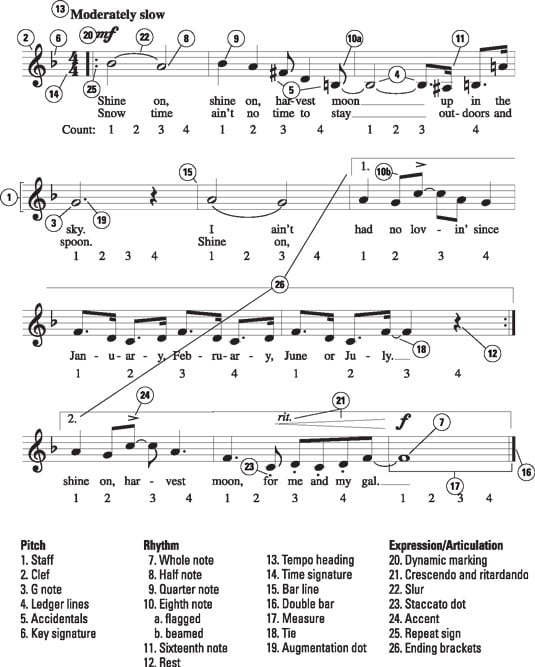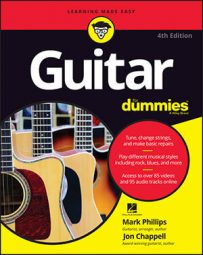Expression and articulation deal with how you play the music. The table, in conjunction with the figure, tells you about the symbols and terms that deal with these issues. The table deals with the symbols numbered 20 to 26 in the figure.

Music for "Shine On Harvest Moon."
| Number in Figure | What It's Called | What It Means |
|---|---|---|
| 20 | Dynamic marking | A dynamic marking tells you how loudly or softly to play. These markings are usually abbreviations of Italian words. Some of the common markings, from soft to loud, are pp (pianissimo), very soft; p (piano), soft; mp (mezzo-piano), moderately soft; mf (mezzo-forte), moderately loud; f (forte), loud; and ff (fortissimo), very loud. |
| 21 | Crescendo and ritardando | The wedge-shaped symbol is known as a crescendo and indicates that the music gets gradually louder. If the wedge-shaped symbol goes from open to closed, it indicates a decrescendo, or a gradual softening. Often, instead of wedges (or, as some musicians call them, "hairpins"), the abbreviation cresc. or decresc. appears instead. Another term you can use to indicate a softening of volume is diminuendo, abbreviated dim. The abbreviation rit. (sometimes abbreviated ritard.) stands for ritardando and indicates a gradual slowing of the tempo. Rallentando (abbreviated rall.) means the same thing. You can indicate a gradual increase in tempo by using accel., which stands for accelerando. |
| 22 | Slur | A slur is a curved line that connects two notes of different pitch. A slur tells you to connect the notes smoothly, with no break in the sound. |
| 23 | Staccato dot | Staccato dots above or below notes tell you to play the notes short and detached. |
| 24 | Accent | An accent mark above or below a note tells you to stress it, or play it louder than normal. |
| 25 | Repeat sign | The repeat sign tells you to repeat certain measures. |
| 26 | Ending brackets | Sometimes a repeated section starts the same both times but ends differently. These different endings are indicated by numbered ending brackets. Play the measures under the first ending bracket the first time, but substitute the measures under the second ending bracket the second time. Taking "Shine On Harvest Moon" as an example, you first play measures 1–8; you then play measures 1–5 again, and then 9–11. |

